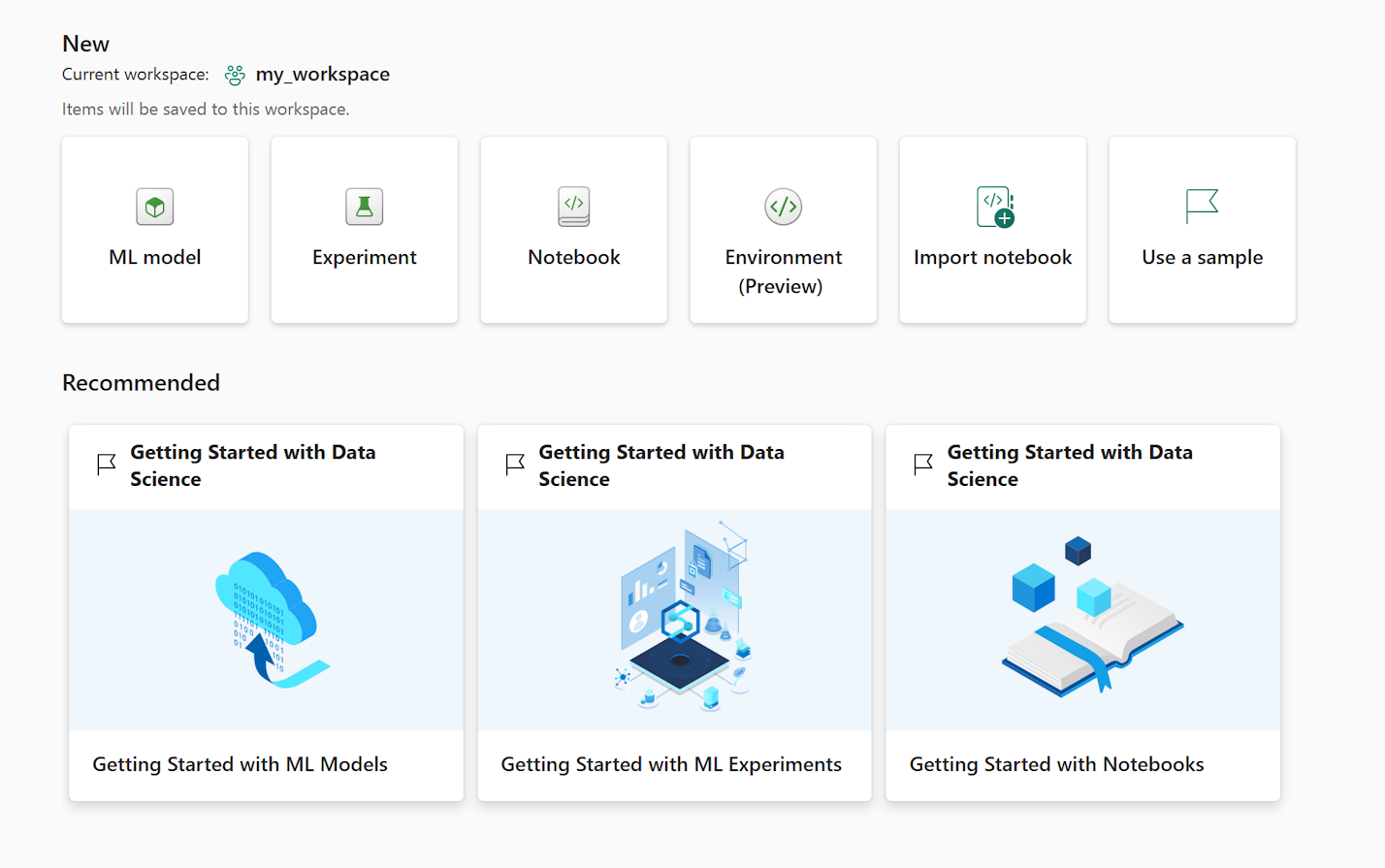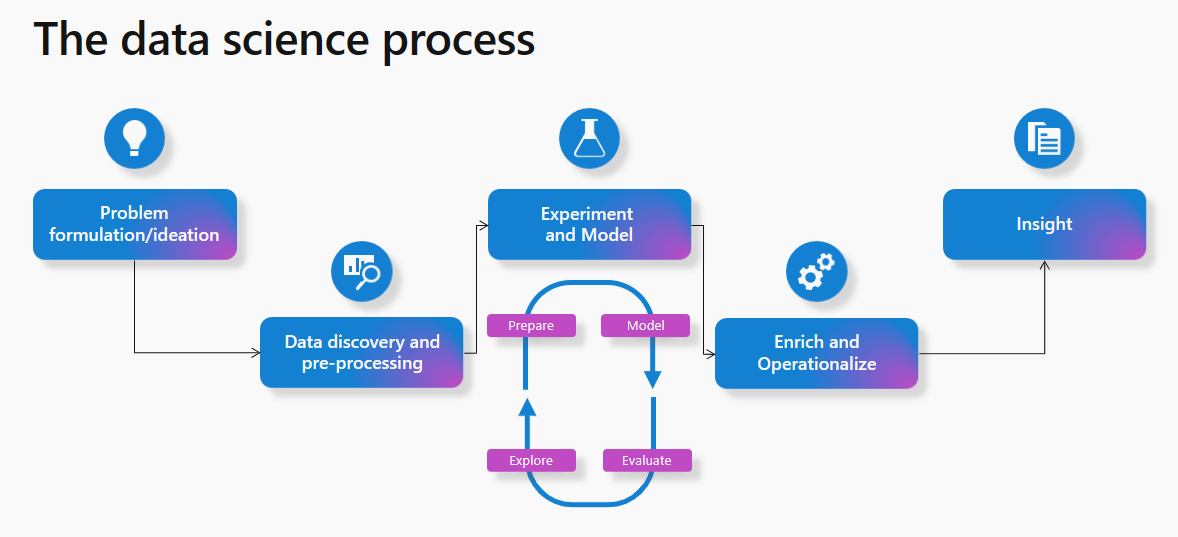Note
Access to this page requires authorization. You can try signing in or changing directories.
Access to this page requires authorization. You can try changing directories.
For data enrichment and business insights, Microsoft Fabric offers Data Science experiences that empower users to build end-to-end data science workflows. To get started, see the Data Science end-to-end tutorial.
You can complete a wide range of activities across the entire data science process:
- data exploration
- data preparation
- data cleaning
- experimentation
- modeling
- model scoring
- serving predictive insights to BI reports
Microsoft Fabric users can access a Data Science home page. Then, they can discover and access various relevant resources, as shown in the following screenshot:
Most machine learning projects follow the data science process. At a high level, that process involves these steps:
- problem formulation and ideation
- data discovery and preprocessing
- experimentation and modeling
- enrich and operationalize
- build insights
This article describes the Microsoft Fabric Data Science capabilities from a data science process perspective. For each step in the data science process, this article summarizes the Microsoft Fabric capabilities that can help.
Problem formulation and ideation
Data Science users in Microsoft Fabric work on the same platform as business users and analysts. Data sharing and collaboration becomes more seamless across different roles as a result. Analysts can easily share Power BI reports and datasets with data science practitioners. The ease of collaboration across roles in Microsoft Fabric makes hand-offs during the problem formulation phase easier.
Data discovery and preprocessing
Microsoft Fabric users can interact with data in OneLake by using the Lakehouse resource. To browse and interact with data, Lakehouse easily attaches to a notebook. Users can easily read data from a Lakehouse directly into a Pandas dataframe. For exploration, seamless data reads from OneLake then become possible.
A powerful set of tools is available for data ingestion and data orchestration pipelines with data integration pipelines - a natively integrated part of Microsoft Fabric. Easy-to-build pipelines can access and transform the data into a format that machine learning can consume.
Data exploration
An important part of the machine learning process involves understanding data through exploration and visualization.
Depending on the data storage location, Microsoft Fabric offers tools to explore and prepare the data for analytics and machine learning. Notebooks themselves become efficient, effective data exploration tools.
Apache Spark and Python for data preparation
Microsoft Fabric can transform, prepare, and explore your data at scale. With Spark, users can use PySpark/Python, Scala, and SparkR/SparklyR tools to preprocess data at scale. Powerful open-source visualization libraries can enhance the data exploration experience for better data understandings.
Data Wrangler for seamless data cleansing
To use Data Wrangler, the Microsoft Fabric Notebook experience added a code tool feature that prepares data and generates Python code. This experience makes it easy to accelerate tedious and mundane tasks - for example, data cleaning. With it, you can also build automation and repeatability through generated code. Learn more about Data Wrangler in the Data Wrangler section of this document.
Experimentation and ML modeling
With tools like PySpark/Python and SparklyR/R, notebooks can handle machine learning model training. Machine learning algorithms and libraries can help train machine learning models. Library management tools can install these libraries and algorithms. Users can then use popular machine learning libraries to complete their ML model training in Microsoft Fabric. Additionally, popular libraries like Scikit Learn can also develop models.
MLflow experiments and runs can track ML model training. To log experiments and models, Microsoft Fabric offers a built-in MLflow experience that supports interaction. Learn more about how use of MLflow to track experiments and manage models in Microsoft Fabric.
SynapseML
Microsoft owns and operates the SynapseML (formerly known as MMLSpark) open-source library. It simplifies the creation of massively scalable machine learning pipelines. As a tool ecosystem, it expands the Apache Spark framework in several new directions. SynapseML unifies several existing machine learning frameworks and new Microsoft algorithms into a single, scalable API. The open-source SynapseML library includes a rich ecosystem of ML tools for predictive model development, and it uses pretrained AI models from Azure AI services. For more information, visit the SynapseML resource.
Enrich and operationalize
Notebooks can handle machine learning model batch scoring with open-source libraries for prediction. They can also handle the Microsoft Fabric scalable universal Spark Predict function. This function supports MLflow packaged models in the Microsoft Fabric model registry.
Gain insights
In Microsoft Fabric, you can easily write predicted values to OneLake. From there, Power BI reports can seamlessly consume them with the Power BI Direct Lake mode. Data science practitioners can then easily share the results of their work with stakeholders - and it simplifies operationalization.
You can use notebook scheduling features to schedule runs of notebooks that contain batch scoring. You can also schedule batch scoring as part of pipeline activities or Spark jobs. With the Direct lake mode in Microsoft Fabric, Power BI automatically gets the latest predictions without need for data loads or refreshes.
Data exploration with semantic link
Data scientists and business analysts spend lots of time trying to understand, clean, and transform data before meaningful analysis can begin. Business analysts typically work with semantic models and encode their domain knowledge and business logic into Power BI measures. On the other hand, data scientists can work with the same data but typically use a different code environment or language. With semantic link, data scientists can establish a connection between Power BI semantic models and the Synapse Data Science in the Microsoft Fabric experience via the SemPy Python library. To simplify data analytics, SemPy captures and uses data semantics as users perform various transformations on the semantic models. When data scientists use semantic link, they can
- avoid reimplementation of business logic and domain knowledge in their code
- easily access and use Power BI measures in their code
- use semantics to power new experiences - for example, semantic functions
- explore and validate functional dependencies and relationships between data
When organizations use SemPy, they can expect
- increased productivity and faster collaboration across teams that operate on the same datasets
- increased cross-collaboration across business intelligence and AI teams
- reduced ambiguity, and an easier learning curve when onboarding onto a new model or dataset
For more information about semantic link, see What is semantic link?.
Related content
- Visit Data Science Tutorials to get started with end-to-end data science samples
- Visit Data Wrangler for more information about data preparation and cleaning with Data Wrangler
- Visit Machine learning experiment to learn more about tracking experiments
- Visit Machine learning model to learn more about model management
- Visit Score models with PREDICT to learn more about batch scoring with Predict
- Serve Lakehouse predictions to Power BI with Direct Lake

